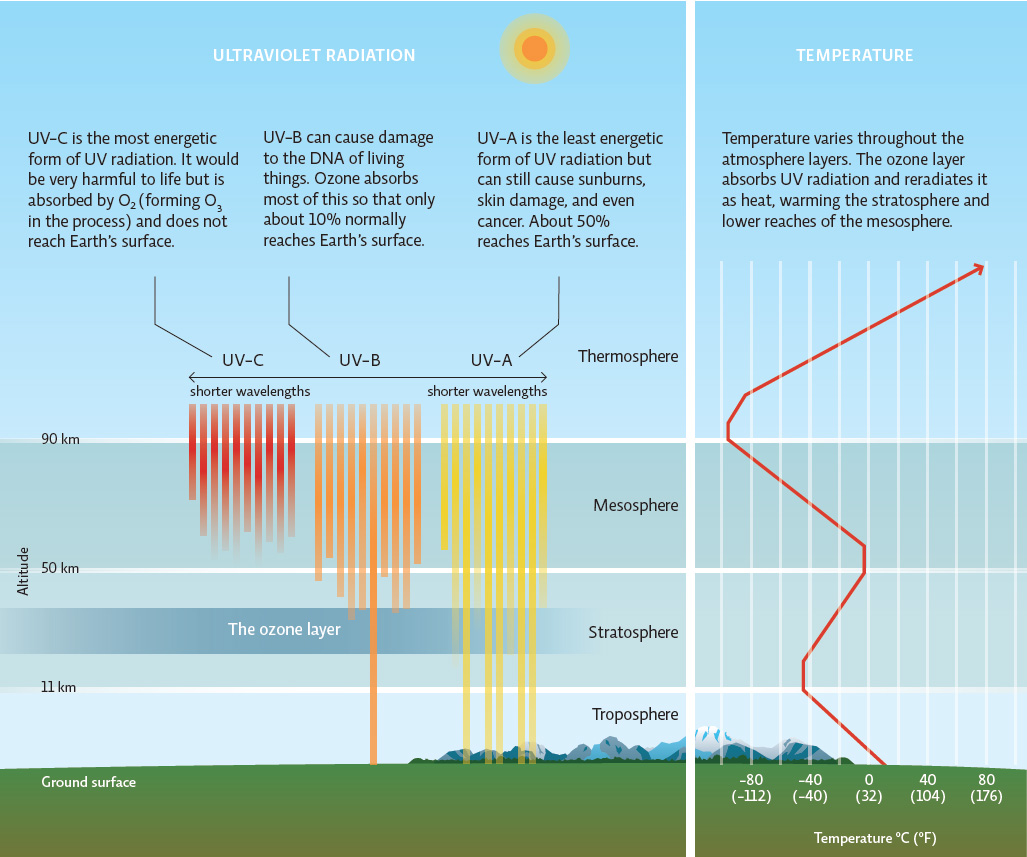The ozone layer protects life on Earth
It was a serious proposition: Without ozone, the world as we know it would not exist. Ozone is a key element of the atmosphere, the blanket of gases surrounding our planet that is made up of discernable layers, which differ in temperature, density, and gas composition. The lowest level, the troposphere, extends about 11 km (7 miles) up from Earth’s surface. This level is familiar to us: It is the air we breathe and where our weather occurs. The next level in the atmospheric blanket, the stratosphere, rises to 50 km (31 miles) above Earth’s surface. The stratosphere is much less dense than the troposphere but contains a “layer” of ozone (abbreviated as O3 because it contains three oxygen atoms), a region where most of the atmosphere’s ozone is found.
Without ozone, the world as we know it would not exist.
atmosphere
The blanket of gases that surrounds Earth and other planets.
troposphere
The region of the atmosphere that starts at ground level and extends upward about 7 miles.
stratosphere
The region of the atmosphere that starts at the top of the troposphere and extends up to about 31 miles; contains the ozone layer.
ozone
A molecule with three oxygen atoms that absorbs UV radiation in the stratosphere.
KEY CONCEPT 2.3
Human actions can significantly alter the natural world we depend on. The stratospheric ozone layer is critical for life on Earth, but human impact is causing its depletion in some areas.
Solar radiation enters the atmosphere every day, including three forms of ultraviolet (UV) radiation: UV-A, UV-B, and UV-C. Each form of radiation travels at a different wavelength, and each differs in its ability to penetrate materials, like skin. In humans, exposure to UV-B radiation increases the risk of cataracts, skin damage, and cancer. Fortunately, ozone prevents most of the UV-B radiation from reaching Earth’s surface, minimizing the damage it can cause to living things. About 50% of incoming UV-A radiation still reaches Earth’s surface, where it can damage skin, cause sunburn, prematurely age the skin, and cause skin cancer. A suntan is actually a response by the skin to the damaging effects of UV radiation and will not necessarily protect an individual from further Sun damage. Stratospheric (good) ozone should not be confused with ground-level (bad) ozone found in the troposphere. Ground-level ozone is a component of smog and is harmful to living things (see Chapter 20). INFOGRAPHIC 2.1
ultraviolet (UV) radiation
Short-wavelength electromagnetic energy emitted by the Sun.
The atmosphere is composed of layers that differ in temperature and chemical composition. There is not much ozone in the atmosphere, but most of what ozone there is occurs in a layer in the stratosphere. Ozone (O3) is important because it prevents some UV radiation from reaching Earth’s surface.


What problems could emerge if the ozone layer lost some of its ozone?
Less ozone in the ozone layer would allow more UVb and UBa radiation through. This could increase the risk of cancer and other damage caused by these UV rays.
Arriving at McMurdo Station, Solomon knew she had to apply the scientific process to understand why the ozone layer was thinning in the Antarctic. And she already had a culprit in mind.